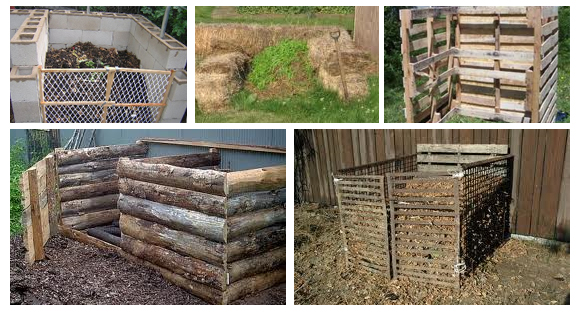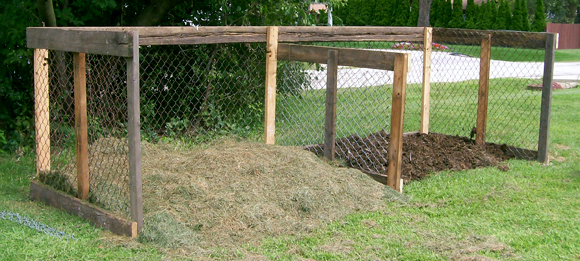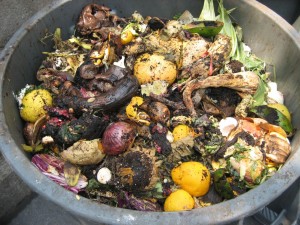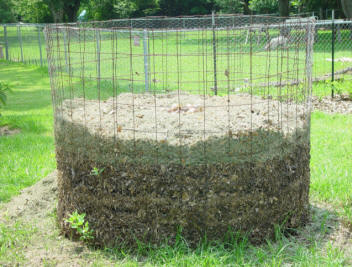Homemade compost bins are infinite, you can make them out of just about anything. Simple or fancy, big or small, they’ve all been done and the design is only left to your imagination. To the compost, it doesn’t matter which design you choose… but YOU want something that looks good and does its job. In all honesty, you don’t need a bin for your scraps to decompose into beautiful, rich soil for your garden. You can literally throw a pile on the ground and it will break down over time. You can even dig a hole or a trench and throw your compost material in. But you wanted something… more, right? so here are a few ideas.
Homemade Compost Bins
Big compost bins shown here are made of cinder blocks, hay, wooden pallets, timber, crates and fencing. If it will hold a pile, it will do the job. When planning a homemade compost bin, consider airflow, moisture retention and overall size (more on this later). If you turn the pile regularly, you can have finished compost pretty darn quick. A 2 bin system like this one holds a spot for finished compost.
I built this compost bin in 2010 out of very old boards hanging out here for years. I looked at the rotten wood and thought, “its going to hold garbage, why not use everything”. The fence was graciously donated by a neighbor. This wonderful bin turned out to be a community dump, for all my neighbors to drop off grass clippings and fall leaves. If you dont need a ton of compost a small container can work, like this garbage can. Its easy to take care of, dump it out, mix it up then pile it back in. Unless you drill holes in the can, it wont drain or breathe well and can get downright stinky. Make sure to turn it often.
This one’s creative! A chicken wire hoop has great drainage and air flow. Being able to disassemble the hoop to turn the pile would be super helpful. Reassemble and scoop the compost back in.
Now that you have a few ideas about how to make a homemade compost bin, here’s a little science to keep in mind when building your own.
Compost Chemistry. The Science of Rotting Garbage.
Heat. The decomposition process generates heat through the microbial breakdown of materials. You might notice steam in the early morning or when you turn the pile. Heat is essential to ‘cook’ your compost pile. When your pile is cooking, you’ll know that its actively decomposing, killing pathogens and weed seeds.
Moisture. You may notice white powdery dry spots in your compost pile, and this is natural, but dry spots are not actively breaking down. The dry pile needs to be turned and watered if needed. Dont over water! A soupy mess wont break down either and may leach nutrients from the pile. ‘wrung out sponge’ is about right.
Oxygen. Microorganisms known for breaking down a compost pile need oxygen to breathe, therefore aeration is a necessity. Turning keeps the pile oxygenated and distributes moisture evenly.
Size. The size of the compost pile also helps the decomposition process. It should be large enough to retain moisture and generate heat and small enough to allow air flow. The recommended size is 3-5 feet wide and tall.
Whats that Smell?
I frequently encounter an ammonia smell which is most reminiscent of animal urine. This is caused by too much nitrogen. Mixing in more carbon rich ‘brown’ material will fix the problem fast. In the early summer when no leaves are available, shredded newspaper helps, so I use it a lot.
If the pile smells rotten, like sewage or rotten eggs, it’s caused by anaerobic activity. Turning the pile adds more oxygen and should relieve that rotten stench.
How often Should I Turn it?
Lots of different opinions on turning compost. Some research says that untouched compost still retains oxygen and heat levels adequately, doing away with the necessity to turn. While that might be true, I simply cant wait a year before my compost is ready. I’ve found that turning the pile breaks it down faster, and have read that, as a rule, every time you turn, it cuts composting time in half! But I hear you, turning large piles of compost is hard work so it’s easy to just let it sit. And that works, but a pile located in direct sun, turned daily, without the addition of new materials, can be broken down in 2-3 weeks. That’s more like it! and worth the effort. In the first few days, I turn with a pitch fork. After the grass clippings have decomposed past the bulky stage, my little Mantis Tiller works like a pro and makes the job a breeze!




